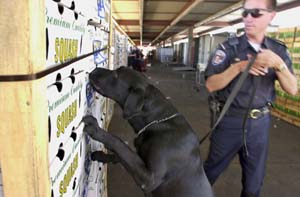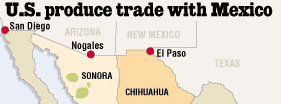

By Jeannine Relly
ARIZONA DAILY STAR
Tucson, Arizona Sunday, 25 March 2001
http://www.azstarnet.com/star/today/10325produce.html

Amid a sea of tomatoes, Jorge Rodriguez, warehouse manager
at Meyer Tomatoes LLC in Nogales, Ariz., inspects a few for quality.
Aaron J. Latham / Staff
More produce on your table today comes from Mexico, where growers
are using the latest technology, fewer pesticides and better sanitation
to overtake Florida as this country's main source of winter vegetables.
This season, Mexico will supply the United States with five times
more cucumbers and nearly four times more eggplant than Florida.
Last year, more than half the cucumbers, squash, eggplant, peppers
and Roma and cherry tomatoes sent to market here came from Mexico.
The Mexican industry's recent success is due partly to harsh weather
in Florida, where freezing temperatures and lingering drought
have destroyed crops and forced growers out of business. But it's
mostly due to changes within the industry itself.
In the past decade, Mexico's elite growers - many of them third-generation
farmers with ties to Arizona - have invested in seeds so precious
they cost more than gold and so advanced they can double production
and triple a tomato's shelf life.
Growers built ultramodern greenhouses that aim to create ideal
growing conditions through precise delivery of minerals, water
and light.
They heavily market their fashionable "vine-ripe" tomatoes
over the Florida alternative: picked green and shot with ethylene
gas.
Southern Arizona is a major beneficiary of those efforts. Mexican
growers send more than 900 trucks a day to the Nogales port of
entry, the major winter-produce hub on the 2,000-mile border.
In Arizona, the industry employs 3,200 people a year - many only
in the winter growing season - and generates $550 million in annual
sales.

Photos by Aaron J. Latham / Staff
U.S. Customs officer Jose Fuentes and Dozer check boxes of squash
for hidden drugs at the Mariposa checkpoint in Nogales, Ariz.
"Nogales is the center of the produce universe," said
Jesse Driskill, manager of Meyer Tomatoes LLC in Nogales.
The industry stands to gain even more from the United States'
recent agreement to honor a part of the North American Free Trade
Agreement that gives Mexican truckers more freedom to transport
produce across the border.
And many consumers are enthusiastic about the taste and safety
of Mexican produce.
"They've really diversified their crops and improved the
quality," said Misko Gilliland, executive chef of Cantina
Romantica at the Rex Ranch Resort in Amado. "It's almost
a night-and-day difference."
But a threat to Nogales' importance in the industry is emerging:
Mexican growers are moving more produce through three ports in
South Texas. Growers said the ports are closer to the East Coast,
open longer and move trucks through more quickly than Nogales.
High tech in a low-tech land
In a country that is still largely rural and low-tech, the Mexican
produce industry is undeniably 21st century.
Growers use seeds, developed in Israel and Belgium, that cost
$12,000 per pound. The most specialized greenhouse varieties can
run $40,000 per pound.
Prices are high, but so are yields: "It doubles production
and it's worth millions," said Driskill, of Meyer Tomatoes.
Growers are always looking for new varieties of vegetables to
dazzle the U.S. market.
Del Campo Supreme Inc. in Rico Rico this year is selling Mexican
orange plum tomatoes, seedless cucumbers and squared-off orange
and red bell peppers, grown to appeal to consumers who shunned
pointy tips, said Martin Ley, the company's general manager.
Many of those vegetables are grown in greenhouses with panes that
slide up and down to control light and heat.
Later, computers sort produce into dozens of colors and sizes
in the packing houses. The best are exported; the rest stay in
Mexico.
1997 setback
Mexico's efforts to become a produce powerhouse took a hit in
1997 when 270 people in five states contracted Hepatitis A from
frozen Mexican strawberries. A U.S. government investigation couldn't
pin the virus on Mexico; the berries had been in this country
for months.

Roberto Lizarraga of Meyer Tomatoes moves produce to a tractor-trailer
for shipment.
A subsequent congressional food safety report said that in 14
years, there were only two other illness outbreaks linked to Mexico
- from salmonella-tainted cantaloupes in 1989 and 1991.
But bad press continued. In 1998, the CBS news magazine Public
Eye said Mexican vegetable pickers defecated in fields because
they didn't have access to toilets - and that produce had dangerous
levels of pesticide residues.
Growers responded with ad campaigns they said were more accurate:
workers in caps, gloves, aprons and masks. They touted use of
insects instead of pesticides. And they contracted with reputable
U.S. companies to inspect their operations.
Pesticide restrictions
Mexico allows the use of less than a third of the United States'
800 registered pesticides, said chemist Amada Velez of the Mexican
government's plant protection division.
"They go with what EPA has established," said Adrian
Garcia, supervisor of the FDA's Arizona border ports. "They
don't want to put themselves in that kind of bind."
Growers do even more than is required of them. In Culiacán,
Sinaloa, government laboratory director Pedro Bastidas said the
number of tests he runs for pesticide residues tripled in the
last two years.

Click on graphic to enlarge
Last year, growers voluntarily brought in 1,000 samples for analysis.
That's in addition to 200 random samples pulled from 115 packing
plants by a grower-sponsored organization.
One test costs a grower $130, but a truckload of vegetables confiscated
at the border for excessive pesticide residue could cost $30,000
in lost sales.
"People are participating because it's their livelihood,"
said Lee Frankel, president of the Fresh Produce Association of
the Americas, in Nogales, Ariz.
On this side of the border, the FDA tests less than 1 percent
of imported produce. Of the 3.5 billion pounds coming through
Nogales, Ariz., the FDA collected 600 samples last year. About
5 percent violated limits, Garcia said. That's the same failure
rate as domestic produce.
Some say the number of inspections is too low.
"It's almost like they are not doing anything at all,"
said Caroline Smith DeWaal, director of food safety for the Center
for Science in the Public Interest, a food industry watchdog group
in Washington, D.C.
But the industry is policing itself. The percentage of violations
in Nogales has remained steady for 10 years, while the volume
of produce has doubled, the FDA's Garcia said.
"They've improved tremendously," he said.
Fighting misperceptions
Media reports of raw sewage and poor living conditions on Mexican
farms have left many consumers with the impression that Mexican
produce is unsafe.
Growers say that's not so.
Sonora and Sinaloa have invited U.S. officials to train managers
in farm safety.
Packing plants use chlorine, ultraviolet light or ozone to purify
water that cleans produce.
Truckloads of vegetables are cleaned by filtered water and a massive
roller brush.
"We've redone our whole packing plant to reassure our customers
that they are getting a safe product," said José Garcia
Reyes, who helps run his in-laws packing plant in Sinaloa.
That's good - but not good enough, said Smith De Waal, with the
Center for Science in the Public Interest.
"It is very important that the industry is taking strides
to improve the quality of the produce," she said. "But
we certainly would be more comfortable if we knew there were more
people on the border checking."
Last fiscal year, the U.S. government tested 600 border produce
samples and found 8 percent had unsafe levels of microorganisms.
So far this year, there have been no positives in Nogales, said
the FDA's Garcia.
Growers seeking new ports
As Mexico's growers gain customers on the East Coast, they are
looking to new ports.
Nogales gets more than 65 percent of the season's border produce
trucks because of the areas nearly 60 warehouses. But Sinaloa
growers now are sending more produce to Texas entry ports, which
are closer to the east, open longer and - with Laredo, Pharr and
McAllen - have more lanes for trucks.
"They have superior crossings in Texas," said Chuck
Ciruli, chairman of the Fresh Produce Association of the Americas.
Industry and government groups are fighting back. They are lobbying
the U.S. government to expand the Nogales port or build a new
one.
"It will take millions of dollars," Ciruli said. "But
the state is losing lots of money when the trucks go to Texas."
* Contact Star Business reporter Jeannine Relly at 573-4213 or
jrelly@azstarnet.com.
© Arizona Daily Star